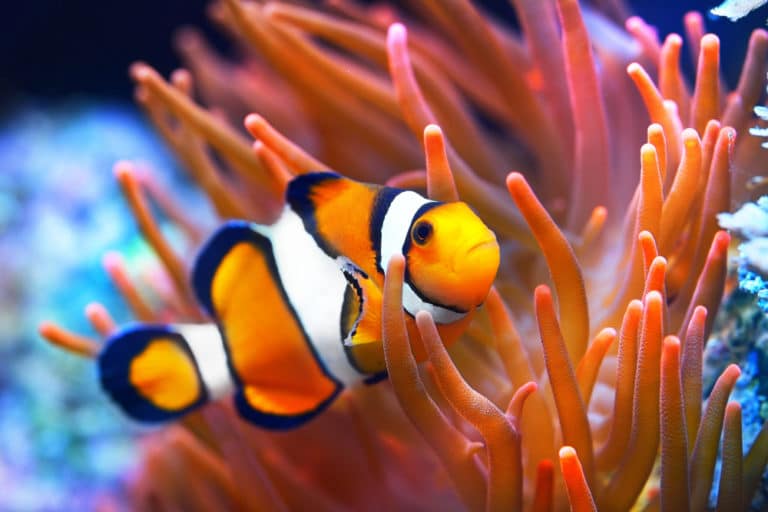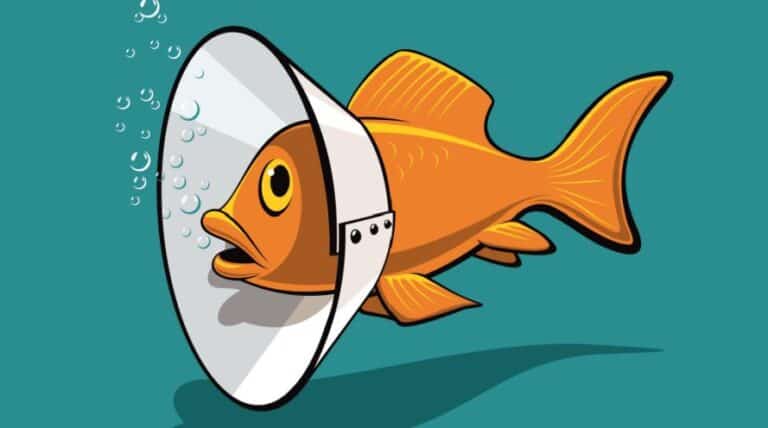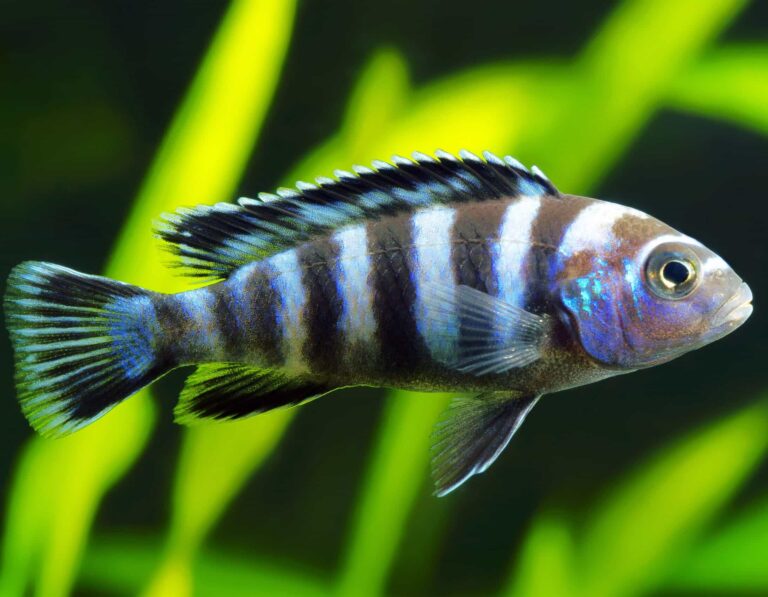So you want to learn some facts about clownfish?

Well, you’re not alone. Clownfish are hands down the most popular fish for people with saltwater aquariums. Although clownfish are active and colorful, their popularity rises from a certain Disney movie that was made in 2003.
The movie is called Finding Nemo. Have you heard of it? 🙂 View Movie - Amazon
If not, I’m assuming you have lived as a hermit in the woods for the past 20 years? Finding Nemo is one of the most successful animated films of all time. Not only did it win an Academy Award, but interestingly it’s the best-selling DVD title of all time, with over 38,000,000 copies being sold since 2006.
But there is more to clownfish than what was portrayed in the movies. Are you ready to learn the whole story?
Then hold on because we have lots of clownfish facts for you.
Thirteen of them, to be exact. 🙂
Fact #1: Not all Clownfish are Orange.
When you think of a clownfish, I’m sure you imagine a fish that is mostly orange with white stripes outlined in black. While this coloration is accurate for most clownfish, they also come in all sorts of colors and sub-varieties.
Let’s start with the white stripes. Most clownfish have them, but they vary widely in both size and color! The lines can be as little as a single white dot on each side, up to nearly being completely colored white with little bits of alternate color here and there. An example is the Maroon Clownfish, who likes to go with a fancy yellow racing-stripe.
A lot of the variation you see with clownfish is from the result of selective captive breeding.
Fact #2: There Are Many Types of Clownfish.
There are at least 28 wild species of clownfish.
Allard’s Clownfish
Most species look like “Nemo,” with an orange body and white stripes. But one type known as Allard’s Clownfish is extremely different. It has a brown-to-black body surrounded by bright yellow fins top and bottom.
Clownfish are sometimes referred to as anemonefish because of their symbiotic relationship with anemones. Check out Fact #4
Some clownfish are just a couple of inches long, but a big fellow like the Maroon Clownfish can grow up to 6 inches. That’s an impressive fish!
Fact #3: Which Type of Clownfish Inspired Nemo?
Nemo may have been designed after the Percula Clownfish (also known as the Orange Clownfish) since they have substantial black outlines on their white bars.
Ocellaris Clownfish
Alternately, the cartoonists may have been trying to show the Ocellaris Clownfish. Also known as the False Percula clownfish, it has very thin (or non-existent) black outlines on its white bars.
Currently, the Percula has some threats to its habitat, while the Ocellaris is widely distributed. This is one reason why many people suggest the Ocellaris is the actual model for Nemo. Letting the capture of a potentially threatened species take center stage might not play out well for a company making a children’s movie!
Fact #4: They Keep Unusual Company.
Other than the movie “Finding Nemo,” clownfish are most known for their mutually symbiotic relationship with sea anemones! As a reminder, a symbiotic relationship in the animal kingdom is one where two different species help each other, and BOTH animals benefit.
Here’s how clownfish and sea anemones work together.
First, clownfish consume any parasites that infest the anemone and also eat any of its dead fingers. So you should not be horrified if you see a clownfish nibbling on its anemone. And in a true symbiotic fashion, clownfish will actually bring food back to the anemone if there is a local shortage.
In return, an anemone protects the clownfish. Anemones have many finger-like tentacles, all of which have poisonous tips called nematocysts. The nematocysts are used to sting fish and kill them for food. Luckily, all clownfish have a thick layer of mucous which protects them from the anemone stingers and allows them to hide amongst its fingers for protection.
Clownfish are quite dependent on their anemone and will rarely venture more than a few yards away.
Fact #5: Clownfish can change sexes. Seriously.
Another thing PIXAR didn’t tell you is that all clownfish are protandrous hermaphrodites. This term means that ALL clownfish are born male. As they mature, some of them will turn into females.
Interestingly, the largest and most dominant clownfish in a group is always a female. The next largest fish is typically the dominant male. If the female dies, the dominant male will become female, and the rest of the males move up in the hierarchy.
Nemo’s dad, Marlin, wouldn’t have remained his father after the mom died. Instead, Marlin would simply have become female, and chosen a new male mate! Also, how come so many parents die in Disney movies?
Should it become necessary for a male fish to become female, this can happen in as little as two weeks. However, a clownfish cannot revert to being a male once the change is complete.
Fact #6: They Have A Varied Diet.
In the wild, clownfish enjoy eating algae, shrimp, plankton, and mollusks! Generally, half of their diet is vegetable, and the other half is meat. They also rely on food provided by their anemone partner, eating some of their leftovers, along with picking off small invertebrate pests from the anemone.
In captivity, clownfish will consume flake, tablet, pellet, and live food (especially fishes, shrimps, and worms). You should try to feed them twice per day. Fry or juvenile clownfish, on the other hand, need to eat about four times per day.
Fact #7: Clownfish & Werewolves Have Something In Common.
Female clownfish will generally lay their eggs on the night of a full moon. Though they live near the bottom of the ocean, they can always seem to tell when “love is in the air”.
A female clownfish may lay as few as 100 eggs but can produce as many as 1,000. After fertilizing the eggs, the male remains on patrol and guards the eggs against predators. If an egg develops a fungus or wasn’t appropriately fertilized, the male will usually eat the eggs.
Meanwhile, the female swims off as soon as she has deposited her eggs.
Once those eggs are laid, it can take anywhere from six to ten days for them to hatch. Interestingly, this always seems to occur just two hours after sunset. Do these guys have telescopes, or are they just natural astronomers?
Fact #8: They Have A Few Natural Enemies
You may like clownfish, but there are a few other fish that like them even better. Lionfish, snapper, grouper, triggers, and eels all find them delicious! Even some sharks species are known to pursue the colorful clownfish.
But remember that the anemone does provide some protection for the clownfish, using its tentacles to deliver a deadly sting to intruders. Clownfish have no defense mechanisms of their own, which is one reason they never stray too far away from their anemone.
Fact #9: “Finding Nemo” had a Detrimental Effect
The movie “Finding Nemo” emphasized that it was bad for people to collect rare fish from the ocean, which is a good message for children. However, it seems that the movie actually had the opposite effect.
Rather than leaving Nemo in his natural habitat, more people started wanting clownfish as pets, including many beginner hobbyists who ended up killing their fish.
The Saving Nemo Conservation Fund was established in response to the demand for wild clownfish. Their website states that over ONE MILLION clownfish are harvested from the wild EVERY YEAR.
Both clownfish and anemones can be found in Indonesia, the Indian Ocean, Singapore, the warm Pacific, the Red Sea, the Solomon Islands, and all over Australia’s Great Barrier Reef. Thanks to overharvesting, they have gone locally extinct in Sri Lanka, the Philippines, and parts of Thailand.
Fact #10: Captive Bred Clownfish are the BEST!
With the demand for clownfish so high, there is a better option than taking them out of the wild. People have been breeding clownfish in captivity for decades, and have an ample supply available for distribution.
Since tank-raised fish have already adapted, they will experience less stress and fewer health problems than wild-caught clownfish. In captivity, clownfish generally live between three and six years, but some owners have reported keeping their pets for more than twenty-five years.
Fact #11: Keeping Clownfish is Harder Than You Think!
Before you go out and buy a clownfish and set up a saltwater aquarium, you need to know that it is not for the beginner aquarist. Please do ample research ahead of time, and you make sure you are committed to the daily task of taking care of your fish. Please consider starting with a freshwater aquarium first before moving up to the challenge of a saltwater tank!
A 30 gallon (115 liters) tank is generally the minimum for a single fish, whereas a pair needs 40 gallons (150 liters) with lots of hiding places to be happy. If you’re going to include an anemone, you’ll need at least a 55 gallon (210 liters) tank to create a sustainable environment.
Clownfish have no particular requirements for lighting, but sea anemones do. Don’t forget to put in a strong, reliable light source if you include one of these animals to support your clownfish.
Make sure you have plenty of hiding spaces if you don’t have an anemone. And verify the species of clownfish and anemone you select are compatible with each other. Many owners have used the wrong type of anemone and found their clownfish “missing” one day.
Speak to a professional about what combinations are appropriate, and remember that anemones add a great deal of work for you. Make sure you are ready for it!
Fact #12: Clownfish are Known to Bite.
With all of this “hiding” that clownfish do inside of an anemone, you might think these fish were timid. In truth, they are quite aggressive and will not hesitate to defend the anemone and their home. For example, they are known to keep the butterflyfish, which eats anemones, away to keep their anemone safe.
In the wild, clownfish have even been known to fight back against sharks that attack them. Scientists have observed the tiny clownfish biting a shark’s tail, and noted that this ferocious creature actually flinched in response!
Clownfish may attempt to bite when you reach in to clean the tank or alter the terrain. You are more likely to experience this if you have wild-caught clownfish rather than captive-bred. Tank-raised clownfish tend to be gentler, and are often very happy to see their owners.
Fact #13: Clownfish Aren’t Bad Singers!
All clownfish make noises by clicking or grinding their teeth to create chirps and pops. Their jawbones act as soundboards (like in a piano) to amplify the sounds.
Varieties such as the Clarkii, Tomato, and Pink Skunk Clownfish are particularly loud singers. When clownfish live peacefully in groups, they use the sounds while they are attacking or defending, or as a form of communication between themselves. Their noises are also used to maintain the rank and file of group members and to minimize conflict.
This video gives you an idea of what clownfish “singing” might sound like.
Final Thoughts
When it comes to clownfish, there is so much more than what meets the eye.
If you decide to raise a clownfish, choose one bred and raised in captivity rather than one snatched up from the wild. It’s the best way to promote responsible breeding and pet ownership.
Can you help me add to this list?











